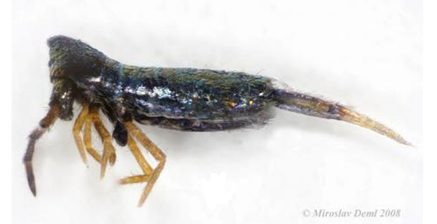Taxonomy: The springtails are tiny parent bugs, that prevalent all over the world.
Kingdom (Regnum): Animals (Animalia)
Phylum (Phylum): Arthropods (Arthropoda)
Subphylum (Subphylum): Hexapods (Hexapoda)
Class (Classis): Entognatha (Entognatha)
Subclass (Subclassis): Springtails (Colembola)
Order (Ordo): Entomobryomorpha
Family (Familia): Gracile springtails (Entomobryidea)
Genus(Genus): Lepidocyrtus
Species (Species): Weird springtail (Lepidocyrtus paradoxus)
Incidence: That is a common parent bug species, which prevalent all over the world.
Living place: Live in marshy or forestal soil, on undergrowth.
Morphology, structure: Springtails are 0,2-9 mm sized parent bugs, whose have six articulated legs. Those have little abdomen, which has six segment. Those haven’t got any forceps. Under part of abdomen have found the springtail (furca).That is an helved appendix with two overhanging prong . The springtail effect of contracture hit against ground, because of the animal can jump high. That move is unguidable.
In begin of the third legpair find the ventral tube, wich is an the fist two abdomen’s segment united tang-shaped appendix. Peak of the tube have two long sac, whose help the breathing in wet air.
Springtails mouth organ’s entotorph, it serve half chewing, half sucking. Those haven’t got any Malpighi-organ, the breathing is in derm in a large measure.
The lepidocyrtus paradoxus is a very pigmented species, with dark blue head-torax-abdomen.
Nutrition: Eat soft based nutritive in soil (decomposing or living herbal pieces)
Manners: The full-growned individuals in after evolving continuing ecdysis, versus majority of insects.
Reproduction: The male springtails are drops spermatofors, and females collect these. These growing called epimorphizm.
The sexual dimorphizm detectable, the females are bigger than males, and they have bigger seta.
Function in ecosystem: Waste eater species, so important creature in the ecosystem.
http://mek.niif.hu/03400/03408/html/2640.html
http://www.eol.org/pages/346870
http://en.wikipedia.org/wiki/Entomobryomorpha
http://en.wikipedia.org/wiki/Entomobryidae
http://en.wikipedia.org/wiki/Collembola
http://www.stevehopkin.co.uk/collembolamaps/Entomobryomorpha/202LEpar/
http://torokjul.web.elte.hu/hexapoda-parainsecta%20jo.pdf
http://www.behav.org/student_essay/insect/collembola_sex_Bati.htm
